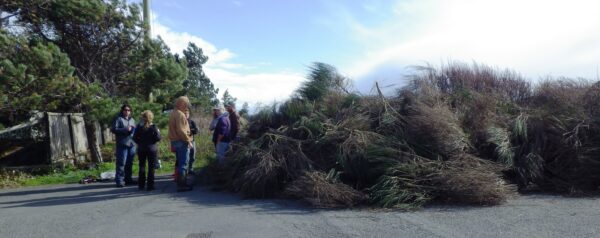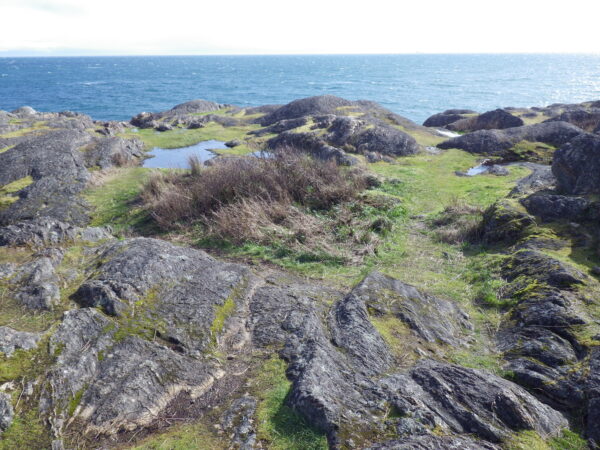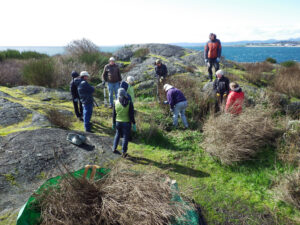Harling Point Restoration Project: Issues and Opportunities

GOERTies and community volunteers removed impressive quantities of Scotch Broom from Harling Point (Oak Bay) in our 2013 work parties (photo: C. Junck, GOERTS)
Harling Point is a small site of natural and cultural significance in Oak Bay, composed of an urban park and private property. A semi-natural coastal area with rare plants and ecosystems, it is nestled next to the Chinese Cemetery National Historic site. The private property, which includes the National Historic Site, is privately owned by the Chinese Consolidated Benevolent Association of Victoria, and the small adjacent park is Oak Bay Municipal land. With permission from the landowners and managers, and support from the Habitat Stewardship Program and Parks Canada Agency, GOERT has been involved in restoration at the site since 2005.
Although the Harling Point restoration project area is only 100m wide by 270m long, and despite the fact that approximately half of the site is occupied by the cemetery’s maintained lawn, Harling Point remains an important site for the survival of seven species of rare plants associated with Garry Oak ecosystems. In Canada, three of the species are found at only a handful of locations. Victoria’s Owl-clover (PDF 1.3MB) (Castilleja victoriae) only exists at Harling Point and three other sites in the world—two in Oak Bay and one area on the San Juan Islands. These rare plant populations are associated with the mosaic of Garry Oak ecosystems found at Harling Point: a rarely-occurring coastal bluff with stunted oaks and dense Snowberry and Nootka Rose; open rocky balds; shallow, well-drained pockets of thin soil; and vernal pools that dry up in the summer. The shoreline is made up of an eroding bank and sloping bedrock.

Rare ecosystems themselves, the mix of vernal pools and rocky balds at Harling Point provide critical habitat for several of Canada’s rarest species (photo: C. Junck, GOERTS)
Coastal bluff and vernal pool ecosystems like Harling Point are threatened by development, recreational use, and exotic, invasive species. One of the major issues GOERTS’ restoration project seeks to address is encroachment of invasive species which threaten to displace the native and rare plants. The invasive culprits degrading the site include Scotch Broom (Cytisus scoparius), English Ivy (Hedera helix), Spurge-laurel (Daphne laureola), Tree of Heaven (Ailanthus altissima), Gorse (Ulex europaeus), Himalayan Blackberry (Rubus armeniacus), exotic grasses, and ornamental plants. Eliminating these weedy, exotic plants requires consistent, repeated removal efforts to address their regrowth. GOERT’s detailed restoration plan for the site begins with removing these invasive plants and replanting with native species to prevent re-invasion. Learn more about best practices for removing invasive species in our field manual, Invasive Species in Garry Oak and Associated Ecosystems in BC.

Matt Fairbarns demonstrates Scotch Broom removal technique to volunteers (photo: C. Junck, GOERTS)
Join us for a work party!
The issues presented by invasive species and the presence of a relatively intact natural area at Harling Point offer an opportunity for enthusiastic individuals to contribute to protecting rare plants and restoring natural habitat.
Volunteers are integral to controlling invasive species at the site. Contact Chris Junck (250-383-3445) if you’re interested in joining a volunteer work party in the fall.